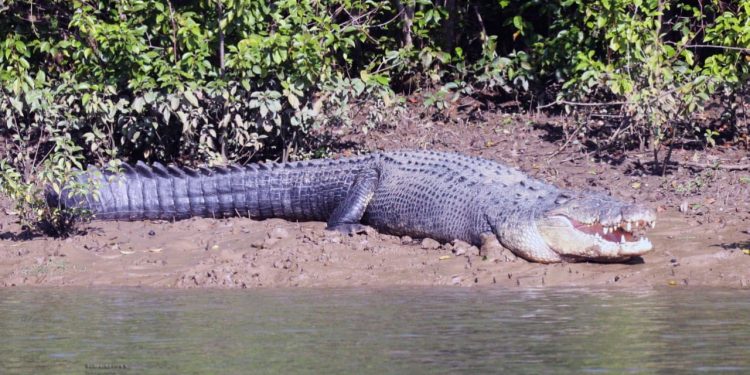Kendrapara: Around 1,742 estuarine crocodiles, including four measuring around 20 feet, were sighted in and around the water bodies of Rajnagar mangrove forest division (wildlife) during the latest census.
The population of the reptiles has increased this year, said Bimal Prasanna Acharya, DFO of Rajnagar mangrove forest division (wildlife).
The census report said the numbers of estuarine crocodiles increased by 44 compared to last year. During the 2018 census, forest officials had counted 1,698 crocodiles.
“Of the 1,742 saltwater crocodiles, the number of hatchlings was 619, yearlings 347 and juveniles (measuring 3 to 6 feet) 273. The number of sub-adults (measuring between 6 and 8 feet) was 178 and adult crocodiles 325,” the DFO said.
“Among the adult crocodiles, 21 were between 14 and 16 feet long, 13 between 16 and 18 feet and nine between 18 and 20 feet. Only four crocodiles exceeded 20 feet,” DFO Acharya said.
The enumerators also sighted 43-year-old captive albino ‘Gori’ and a 10-year-old of the same type during the headcount.
The enumerators spotted 1,337 saltwater crocodiles inside the Dangamala Scheme pond and in the Kanika Wildlife Range, while 229 crocodiles were spotted in Rajnagar range, 72 in Mahakalapara range and 34 in Gahirmatha range, the DFO said.
The headcount was held from January 6 to January 14, 2019, by 22 enumeration teams comprising forest personnel, crocodile experts and researchers in the creeks, rivers and canals in and outside the Bhitarkanika Wildlife Sanctuary and the Mahanadi delta region.
The census method adopted was individual total count by direct day and night time sighting. Each census team was given a census kit (comprising map of the area showing rivers and creeks, route, binoculars, spotlight, notebook, pens/pencils, day and night census forms, VHF sets etc).
Small boats were used for the day and night counting of crocodiles in the narrow creeks, said DFO Acharya.
The enumerators counted crocodiles that were above six feet long during the day, and during the night they counted crocodiles that were less than six feet long. Be it day or night only some crocodiles will be visible. The others will be submerged in water.
The day and night census was supervised by expert Dr Sudhakar Kar deputed from Wildlife Headquarters, crocodile researcher Dr Shiba Prasad Parida and Rajnagar DFO Bimal Prasanna Acharya.
Saltwater crocodiles are now on the verge of extinction in Kerala, Tamil Nadu and AP. They are seen only rarely in West Bengal’s Sunderbans, but are abundantly found in the creeks and rivers of Bhitarkanika National Park. The mangrove eco-system of Bhitarkanika, which is the second largest mangrove forest in India after Sunderbans, hosts the largest population of saltwater crocodiles, including white albino crocodiles.
The micro-region on the interface of land and sea is an outcome of the interacting fluvial and marine processes of the tropical zone. The unique environment of this micro-region is an ideal habitat for crocodiles, said crocodile expert Dr Sudhakar Kar.
Bhitarkanika is the only place in India where saltwater crocodile headcount has been going on every year from 1976, said Dr Kar.
PNN







































